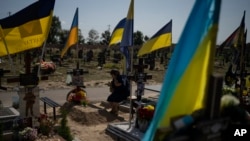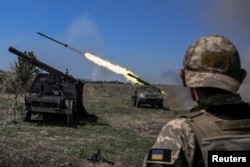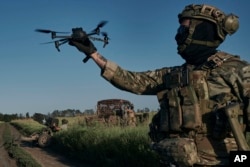On August 23, Russian President Vladimir Putin met with Leonid Pasechnik, the acting head of the Luhansk People’s Republic — a Moscow-controlled breakaway enclave in eastern Ukraine.
Their discussion in the Kremlin covered Russia’s war in Ukraine.
Russian state broadcaster RT reported that Ukraine’s counteroffensive had expended much manpower and equipment but failed to yield any significant territorial gains.
Summarizing Putin’s comments, RT said: “Ukraine is senselessly turning its own soldiers into cannon fodder for Russian troops” and is “not treating their own soldiers as humans.”
Or, in Putin’s words:
“They are throwing [Ukrainian soldiers] on our minefields, under our artillery fire, acting as if they are not their own citizens at all. It is astonishing.”
That is false.
The RT article cited concerns expressed by Western officials in recent weeks over whether Ukraine’s counteroffensive will succeed.
However, contrary to Putin’s claims, a key reason for those concerns has been Ukraine’s efforts to avoid unnecessary combat losses.
Putin and others have written off Ukraine’s counteroffensive as a failure since it was launched in June. A Washington Post report published on August 17 was one in a series of recent articles suggesting Western officials are increasingly skeptical Kyiv will be able to reclaim large swaths of territory Russia has captured in eastern and southern Ukraine.
Russia currently occupies roughly a fifth of Ukraine.
The Washington Post article, citing a U.S. intelligence assessment, said that Ukrainian forces would fail to reach the southeastern city of Melitopol, which would prevent Kyiv from meeting “its principal objective of severing Russia’s land bridge” to the Russian-occupied Crimean Peninsula.
The Institute for the Study of War, a Washington D.C.-based think tank, and other analysts dispute that capturing Melitopol is the only way for Ukraine “to sever the Russian land bridge.”
U.S. officials have also said that Ukraine’s tactical failures have stalled the counteroffensive. They believe Ukraine has deployed too much of its forces to the east, thus hamstringing their ability to make a breakthrough in the south.
The Institute for the Study of War and other analysts dispute that Ukraine’s tactical shift has been ineffective.
Ukraine has recaptured over 50% of the territory Russia seized after invading on February 24, 2022. However, estimates suggest they have only taken a sliver of that territory — approximately 100 square miles — since June.
General Valerii Zaluzhnyi, the commander of the Ukrainian armed forces, told U.S. officials his forces are on the cusp of a breakthrough, the Wall Street Journal reported on August 24.
The pace of Ukraine’s counteroffensive and its choice of tactics reflect a desire to stem casualties.
In May, Britain’s Defense Ministry said Russia had “constructed some of the most extensive systems of military defensive works seen anywhere in the world for many decades,” including “a particular effort to fortify the northern border of occupied Crimea.”
Russia’s artillery-backed defensive fortifications, including trenches, razor wire, anti-tank traps and kilometers-wide minefields — some with up to five mines per square meter — have created a formidable obstacle to Ukrainian advances.
“All of these defenses are laid out in a zig-zag pattern which enables mutual fire support between trenches and ensures obstacles such as the minefields, the lines of dragon’s teeth [concrete pyramids designed to hold up armored vehicles] and the anti-tank ditches are covered by both direct and indirect fire weapons,” wrote Steve Brown, a former British Army ammunition specialist and bomb disposal officer, in the Kyiv Post.
Russian tactics to destroy mine-clearing equipment, including stacking mines on top of each other, has often forced Ukrainian sappers to clear mines manually, sometimes by crawling across minefields.
Russia has also been able to replant cleared mine fields using drones.
The Washington Post reported that "Ukraine incurred major casualties against Russia’s well-prepared defenses” in the first week of the counteroffensive.
Western officials had anticipated that Kyiv would accept those losses “as the cost of piercing through Russia’s main defensive line.”
Instead, Ukraine “chose to stem” those battlefield losses through a tactical shift that involved what Mykola Bielieskov, a research fellow with the National Institute for Strategic Studies, a Ukrainian-government think tank, called “a slow attrition process,” involving small-scale engagements across the front.
The New York Times reported that clearing minefields is “a painstakingly slow process,” and “almost any big push against dug-in Russian defenders protected by minefields would result in huge numbers of losses.”
That, U.S. officials fear, has made Ukraine “become casualty averse.”
Likewise, The Financial Times reported that U.S. officials have pressed Ukraine “to be less risk-averse” to increase the chances its forces can break through Russian lines in the south.
Ukrainian officials said minimizing casualties is necessary to preserve Ukraine's longer-term fighting potential, The Wall Street Journal reported.
Lawrence Freedman, an emeritus professor of war studies at King's College London, said there is a difference between being risk-averse and reckless. He argued that it is not clear Ukraine would have made greater gains if they had mounted larger-scale assaults, “although the casualties would certainly have been higher.”
“Ukraine is pushing back slowly but surely, imposing heavy costs while eating away at Russian capabilities,” Freedman said.
For its part, Russia relied on "human wave attacks” during its winter offensive in eastern Ukraine, resulting in massive casualties, particularly among Wagner Group mercenaries.
Unnamed U.S. officials recently told The New York Times that half a million Ukrainian and Russian troops have been killed since Russia launched its full-scale invasion in February 2022.
Russian forces made up 300,000 of those estimated casualties, including 120,000 deaths. Ukrainian deaths were estimated at 70,000.
Neither Russia nor Ukraine has released comprehensive casualty estimates.








